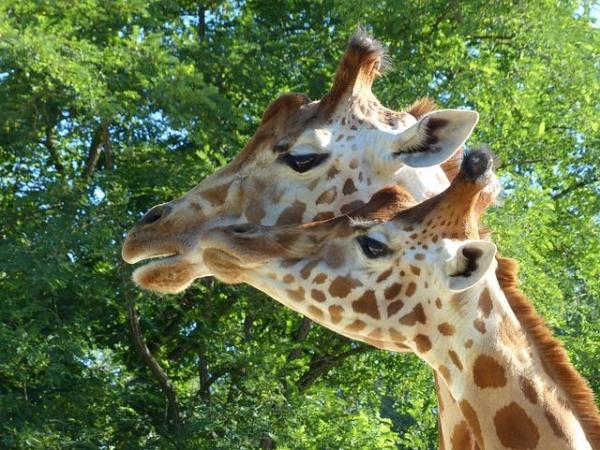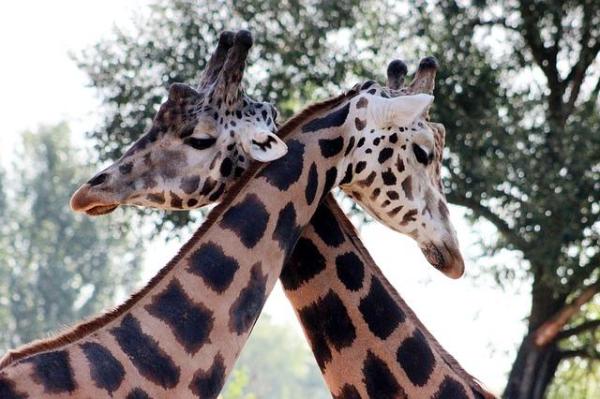How Do Giraffes Communicate?


Giraffes, the majestic giants of the savannah, have long captivated our imagination with their towering stature and graceful presence. Yet, beyond their remarkable physical attributes, these gentle creatures possess a complex and nuanced system of communication that allows them to navigate their social dynamics and transmit vital information within their herd. Despite their reputation for silence, recent research has unveiled a fascinating world of giraffe communication, unveiling the intriguing ways in which they convey messages to one another.
In the following AnimalWised article, we explain the fascinating world of giraffe communication, exploring their unique methods and intricate ways of conveying messages.
How do giraffes communicate?
Giraffes have a diverse and complex communication system, allowing them to interact effectively both nearby and from a distance. They utilize various means of communication, including physical or tactile, chemical, visual, and auditory methods, to transmit information.
Physical or tactile communication
Physical or tactile communication plays a significant role, particularly among males, as they engage in behaviors to measure strength, establish group hierarchy, and gain mating privileges. Males signal their intentions through body posture, walking upright with their heads held high and legs firm. They often engage in an activity called "necking," where they cross their long necks and exert pressure against each other. This can be a test of strength, with the male maintaining the most secure position emerging as the winner.
Alternatively, necking can escalate into more violent confrontations, where the males forcefully strike each other using their ossicones. These bony structures, similar to horns, can cause severe injuries such as neck fractures. However, after such conflicts, males may engage in caressing behaviors and coexist peacefully within the same group.
Chemical communication
Chemical communication plays a significant role in the communication system of giraffes. They possess a well-developed sense of smell, which enables them to detect and interpret various odors in their environment effectively.
One fascinating aspect of chemical communication in giraffes is the behavior of male giraffes tasting the urine of females to determine their reproductive status.
The male giraffe engages in a distinctive process where he stimulates the female to urinate and then analyzes the chemical compounds present in the urine, including hormones. This analysis provides valuable insights into the female's physiological readiness for reproduction. By assessing the signs and indications derived from the urine, the male can determine whether the female is in a favorable state for mating. If the signs indicate a positive reproductive condition, the male proceeds with the mating process. However, if the female's condition is not suitable for reproduction, the male will actively seek another potential partner. This intricate chemical communication mechanism plays a crucial role in facilitating successful reproduction and mate selection among giraffes.
Visual communication
Visual communication plays a significant role in the communication system of giraffes, especially in terms of prevention and threat detection.
Their remarkable height gives them a distinct advantage, allowing them to survey extensive areas and identify potential dangers from a distance. When a giraffe spots a threat, they rely on visual signals to communicate this information to the rest of the herd, initiating a collective response.
Through visual cues, such as body language and gestures, giraffes alert the herd, preparing them for potential danger. This visual communication serves as an early warning system, allowing the entire group to be on high alert and ready to defend themselves. In the face of a threat, giraffes employ their primary defense mechanism: powerful kicks, which can deliver substantial force.
Auditory communication
Giraffes communicate through auditory signals by emitting a variety of sounds, which play a role in their social interactions. Although some of these sounds are audible to humans, they are not frequently encountered. However, a significant portion of giraffe communication takes place through infrasound, which consists of sound frequencies below the range of human hearing and is often undetectable by many other animals.
Infrasound serves as a crucial means of communication for giraffes, allowing them to convey messages and maintain social connections over long distances. By utilizing their vocal cords, giraffes produce low-frequency vibrations that carry information including warnings, territorial signals, and reproductive cues. These infrasonic signals possess the ability to travel great distances without being impeded by obstacles or terrain.
Although humans may not perceive infrasound, it holds vital importance in the intricate communication system of giraffes. It enables them to establish and reinforce social bonds, transmit essential information, and navigate their expansive habitats effectively. By utilizing both audible sounds and infrasound, giraffes employ a diverse range of auditory signals to interact and communicate within their social groups.
Discover the secrets behind the remarkable anatomy of giraffes and unravel the mystery of why they possess such extraordinary long necks.

Do giraffes have vocal cords?
While it is true that in some studies on the anatomy of the giraffe's mouth, vocal cords are not mentioned or described, suggesting that they may not possess them, this does not mean that giraffes are mute. The long-standing belief that they were silent creatures has been proven to be inaccurate.
In reality, giraffes engage in constant communication through very low-frequency sounds, although they also emit occasional audible vocalizations.
These deep rumbling sounds occur at frequencies below the range of human hearing, making them difficult for us to detect. Infrasound has the ability to travel long distances, allowing giraffes to communicate with one another across vast areas. Although we may not perceive these infrasound signals, they play a crucial role in long-distance communication among giraffes.
In addition to infrasound, giraffes do emit audible vocalizations on occasion. While these sounds may not be as frequent as their infrasound communication, they are still part of their communication repertoire. The specific vocalizations can vary and may include snorts, grunts, and other audible sounds. While not as prevalent as their low-frequency communication, these audible vocalizations serve as additional means of conveying messages within their social group.
Don't miss out on our article exploring the fascinating topic of giraffe sleep patterns and how they manage to rest.

What types of sounds do giraffes produce?
In addition to infrasonic sounds, giraffes are capable of emitting a variety of vocalizations. These include: grunts, moans, snores, whistles, and cough-like sounds.
These vocalizations serve as a means of communication, particularly when issuing warnings in alert situations. A distinct grunt or snort can be employed to convey a sense of alarm or to communicate potential danger to other giraffes.
Moreover, when mothers are unable to visually locate their calves, they call out to them using audible sounds. The young giraffes respond in turn by producing their own noises, facilitating reunions within the herd. This vocal interaction between mothers and their offspring strengthens the bonds and communication within the giraffe social structure.
During courtship, male giraffes may engage in a unique vocalization behavior by emitting a strident cough-like sound towards the female. This specific vocal display is part of the courtship ritual and serves as a means of communication to attract the attention of potential mates.
If you want to read similar articles to How Do Giraffes Communicate?, we recommend you visit our Facts about the animal kingdom category.
Pérez, W., Michel, V., Jerbi, H. and Vazquez, N. (2003). "Anatomy of the giraffe ( Giraffa camelopardalis rothschildi ) mouth". International Journal of Morphology. Mexico. Available at: https://www.scielo.cl/scielo.php?script=sci_arttext&pid=S0717-95022012000100057
Altas, R. (2002). "Silent Sentinels?" Nature . Available at: https://www.pbs.org/wnet/nature/tall-blondes-silent-sentinels/2256/
Maisano, S. 2006. " Giraffa camelopardalis " (online), Animal Diversity Web . Accessed July 29, 2021 at https://animaldiversity.org/accounts/Giraffa_camelopardalis/
NATGEO Spain (2020). "Golden shower between giraffes before mating". Available at: https://www.nationalgeographic.com.es/naturaleza/lluvia-dorada-entre-jirafas-antes-apareamiento_15503







